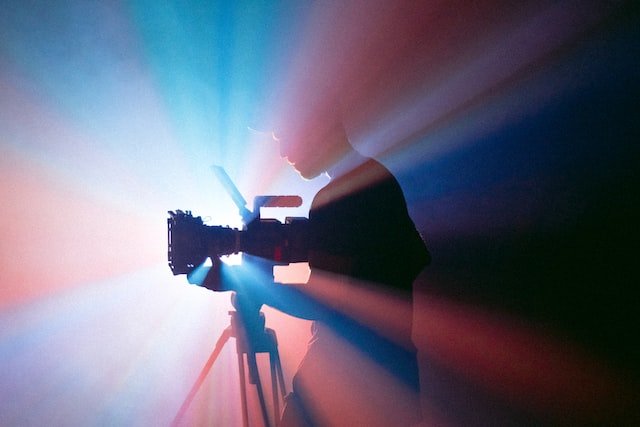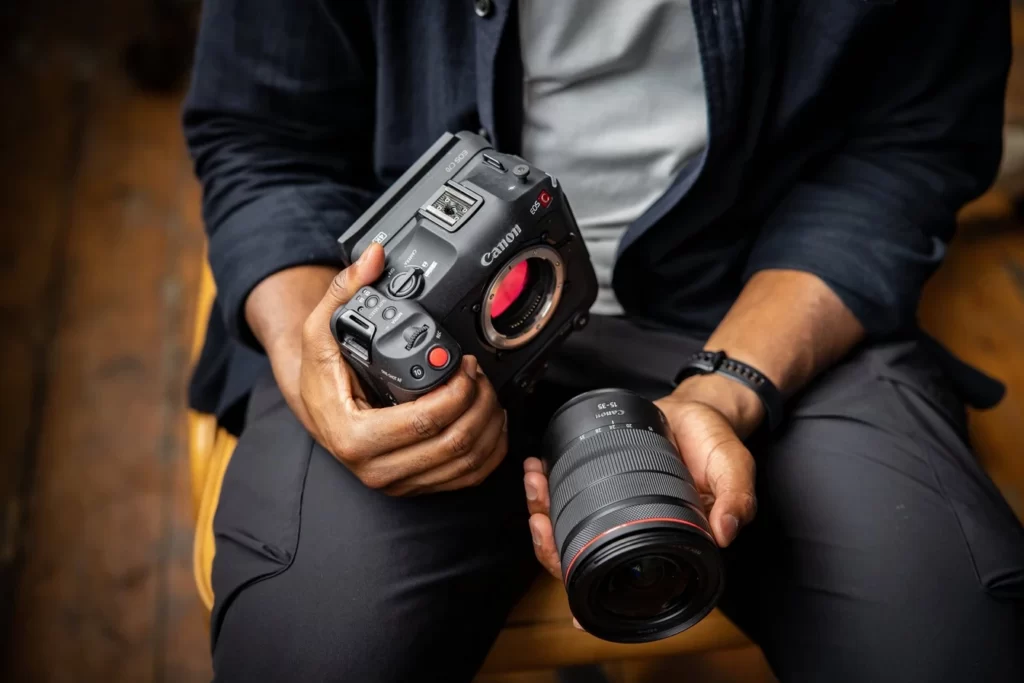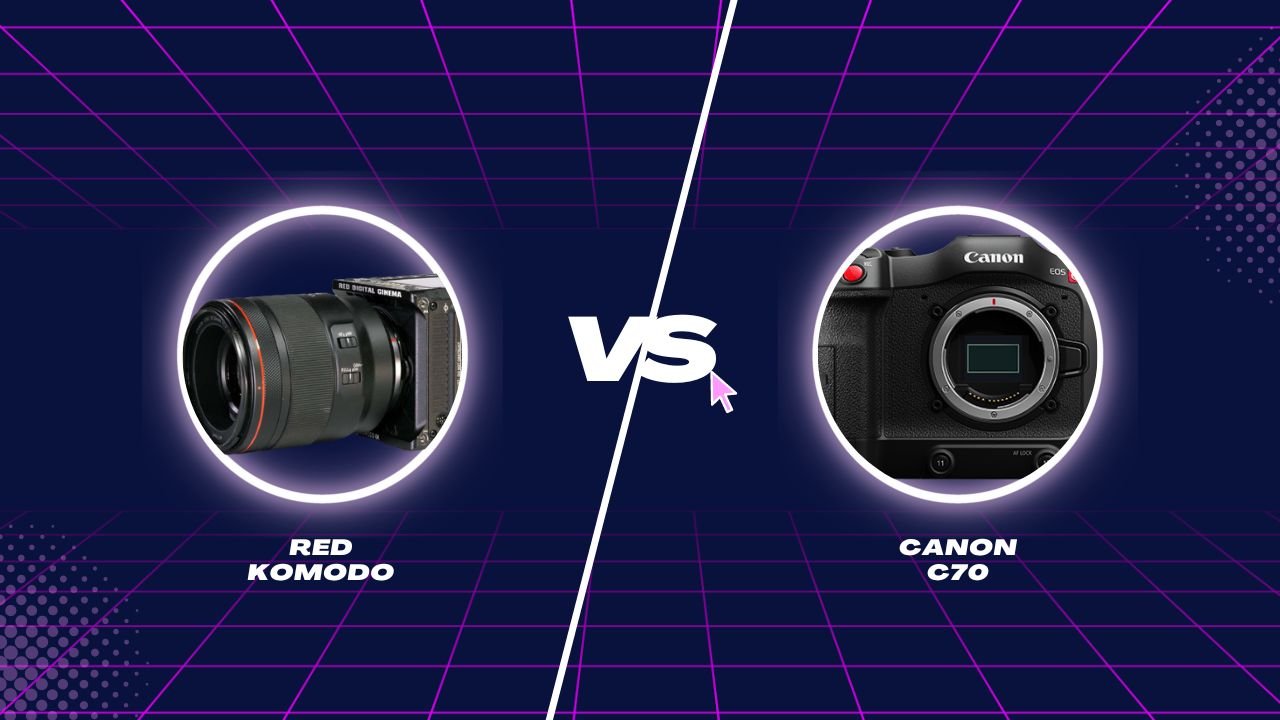This article covers Red Komodo vs Canon C70, Which One Is Better For You?
I have had the opportunity to work with two top-tier cameras that many people are considering right now: the Canon C70 and the Red Komodo. Although these cameras have distinct features that cater to different users. I decided to share my experiences with both cameras over the last couple of months, highlighting their strengths and helping you determine which one may be more suitable for your needs.
Both cameras fall within the sub-$10,000 range, which is the sweet spot for many indie filmmakers like myself. These cameras aren’t for beginners, but they serve as worthy upgrades from hybrid mirrorless cameras or DSLRs.
This isn’t the first time the camera industry has seen such a face-off. I vividly remember the 2011 rivalry between the Canon C300 and the original Red Scarlet. The C300, with its 1080p resolution, lagged behind the Red Scarlet in terms of specs. However, the C300’s ease of use, built-in ND filters, superior audio, and longer battery life ultimately won over filmmakers. The Red Scarlet was considered too watered down for cinema professionals who were already using Red Epics.
Now, it seems we have a similar debate on our hands with the Canon C70 and the Red Komodo.
Red Komodo vs Canon C70 Which Is Better
The Canon C70 offers an incredible 4K resolution at up to 120 frames per second, which is perfect for certain projects. On the other hand, the Red Komodo’s ability to shoot in 6K RAW is ideal for another set of users. Like many of you, I found value in both cameras and even decided to acquire both of them, as they undoubtedly excel in their respective domains.

What is your current filmmaking requirement?
However, before diving into the details of each camera, I encourage you to reflect on your current and future filming needs. Ask yourself two essential questions: What am I currently filming (e.g., documentary work, music videos, commercial work, YouTube content), and what do I plan on shooting in the future? Knowing the answers to these questions will help you align your priorities with the features offered by each camera.
By the end of this blog post, I hope to provide you with the insights needed to make an informed decision and ultimately “pull the trigger” on the camera that best fits your needs.
As a professional filmmaker, I often find myself being asked which camera is my favorite – the Red Komodo or the Canon C70? The truth is, it all depends. I know that’s not the answer you want to hear, but it really does depend on the type of filmmaker you are and where you envision your career heading.
Overview Of Both The Cameras

The Red Komodo is a 6K Super 35mm cinema camera, and it’s truly an impressive piece of equipment. It has the capability to shoot Red R3D RAW in 6K with a global shutter, all while recording internally to CFast cards. This makes the Komodo a high-end yet competitively priced Red camera. When comparing it to other cinema cameras, you need to consider the existing lineup of Red cameras to understand its unique advantages.
What sets the Komodo apart is how seamlessly it integrates with Red’s existing ecosystem. Originally intended as a crash cam or a high-quality GoPro alternative, many filmmakers, including myself, have discovered that it’s actually an excellent entry point into the Red ecosystem. However, diving into the Red ecosystem is not a simple task, and there are significant reasons for doing so.
While the C70 is an outstanding camera, capable of shooting 4K at up to 120 frames per second, it lacks RAW outputs. This is one area where the Komodo has an advantage.
The C70 does have a unique feature, though: dual gain ISO.This camera essentially records at two different ISOs simultaneously, merging them into a single image to deliver impressive dynamic range.
When I put the C70 and the Komodo side by side, their dynamic range is quite comparable. However, the Komodo does provide a few extra stops, giving it a slight edge in this department. Additionally, the 6K sensor on the Komodo results in a sharper and more detailed image.
Brief Comparison between Red Komodo and Canon C70

In my opinion, the Komodo does outperform the C70 in terms of image quality and sensor data, but that’s not the whole story. The C70’s strength lies in its design, offering built-in features that eliminate the need for external rigging. This contrasts with the Komodo, which requires a rig for optimal use. With the Komodo, even a simple setup like an out-rigger handle, monitor, and a couple of batteries might not be enough when faced with challenges like bright outdoor lighting. In those situations, you’ll need additional accessories like a matte box and ND filters.
On the other hand, the C70 caters to run-and-gun filmmakers, documentary creators, or one-person crews who prefer to carry less gear. The C70 has everything built-in, but it comes at the cost of not having the best sensor for its price point. This is where the main distinction lies for me.
When comparing the C70 and Komodo, ask yourself what you’re paying for. With the Komodo, I’m investing in Red’s sensor technology. The value of Red sensors, Red RAW, and global shutter might not be essential to everyone. In such cases, the C70 is the obvious choice.

Ask Yourself First, Which one suits you best.
However, if you’re considering the Red sensor, ask yourself why. Do you want maximum dynamic range? The ability to send R3D RAW files to post-production with ample color grading room? Or perhaps you need a global shutter for fast-moving subjects without shutter lag?
Conversely, if you’re not concerned about those features, the C70 might be your go-to camera. Suppose you’re a one-person band or a documentary filmmaker who despises dealing with ND filters, audio inputs, external monitors, or bulky V-mount batteries and rails. In that case, the C70 provides an all-in-one, compact package, ready for action.
As a filmmaker, understanding the unique offerings of each camera has been invaluable in capturing the perfect shot.
In my opinion, the C70 is probably the better camera for most filmmakers. There’s no need to consider the Komodo if you’re not already leaning in that direction. It’s only when you have a penchant for shooting with RED and understand the benefits of the Komodo that it becomes a viable option.
I realize that some of you might be drawn to the Komodo due to the allure of the RED brand. However, as a professional filmmaker, it’s my responsibility to select the tool that best enables me to excel at my craft. While both the Komodo and C70 have their respective strengths, it’s crucial to consider your specific needs and the context in which you’ll be using the camera. Ultimately, it’s about picking the right tool for the job and ensuring that you can deliver the highest quality work for your clients and projects.

Slow Motion Capabilities: Red Komodo vs Canon C70
- Frame rate is a crucial factor when choosing between Canon C70 and RED Komodo, particularly for slow-motion shots.
- C70 offers 4K at 120fps without cropping, and 180fps in 2K resolution.
- Komodo needs to crop to 2K to achieve 120fps.
- Komodo can shoot 4K at 60fps but requires cropping due to its native 6K sensor.
Low Light Performance and Color Science Of Both The Cameras
Regarding low-light performance, neither camera excels, but the C70 outshines the Komodo. The C70’s maximum ISO of 12,800 appears usable, while the Komodo’s performance falters at this level. However, the noise on the C70 at higher ISOs looks digital, and I would personally avoid surpassing 10,000 ISO if possible.
Color science is a contentious subject, and it often comes up in discussions about these two cameras. The RED color science is unique and highly coveted in Hollywood and among high-end content creators and freelance shooters. The Canon C70 produces impressive visuals, but it lacks the “it factor” that the RED possesses. The C70 can shoot 10-bit 4:2:2 C-log, Canon’s flattest profile, but it doesn’t offer the flexibility of RAW or the charm of the RED.
Nonetheless, the C70’s DGO (dual gain output) sensor looks fantastic. It’s the same sensor found in the high-end C300 Mark III, ensuring top-notch quality.
Workflow Perspective
While the Komodo has been making waves with its color science, raw recording, and global shutter, I must admit that it loses some of its appeal when compared to a camera like the Canon C70. The C70 offers an all-in-one solution with features such as a flip screen, and a plethora of buttons and functionalities packed into a single body.
One of the primary reasons to consider the Red Komodo is the R3D RAW format. This format provides unparalleled latitude in the editing workflow when using Red cameras. Shooting in RAW allows you to adjust essential settings such as white balance, ISO, and tint during post-production. This flexibility can be invaluable for ensuring your footage looks exceptional, even if you didn’t quite nail all the settings in-camera.
From a workflow perspective, the C70 is fantastic for those who need fast turnarounds. I shoot 4K 4:2:2 on one card and a proxy on the other, and my editing process is seamless. I can quickly link proxy files to the original ones, resulting in a stunning output that’s easy to edit. In contrast, the Red raw files are massive and demand a substantial amount of GPU power, causing my modest M1 Mac to struggle.
Autofocus on Red Komodo and Canon C70

When it comes to autofocus, the Komodo’s performance is surprisingly good with both the booster and standard EF adapter. I can effortlessly touch the screen to lock focus on my subject without much hunting. Although it lacks face tracking and is still a work in progress.
You can operate the camera independently using the excellent Red app on their phone to control settings and focus.
As expected, the C70’s autofocus is superb, given Canon’s reputation. However, it’s the face-only mode with face tracking that truly sets it apart from other cinema cameras. In this mode, the autofocus locks onto and tracks a face; once the face leaves the frame or turns away, the camera maintains its last focus point. This feature is the ideal blend of manual focus and autofocus, preventing the amateur and lazy look that constant focus tracking can create. I truly hope other camera manufacturers take note and implement this unique feature in their future models.
What camera am I currently shooting with and how does it fit my needs?
In my experience, if you’re working on documentaries, run-and-gun projects, commercial projects, or music videos, the Canon C70 is definitely a suitable choice. However, if you have the luxury of time to fine-tune your camera settings, work with a small crew, and truly optimize your setup, the RED Komodo is an excellent investment, delivering unparalleled image quality. It’s essential, though, to consider whether it fits your workflow, if you’re prepared for the additional purchases that come with it, and ultimately, if it’s the best tool for your job.
After the EOS R5 overheating debacle, the C70 came as a breath of fresh air. The RED Komodo, on the other hand, is like a scaled-down version of RED’s high-end cinema cameras, but it shouldn’t be underestimated.
The RED Komodo is an intriguing piece of equipment. Its compact size allows me to place it in tight spaces effortlessly. Interestingly, both the Komodo and the C70 have RF mounts, making them compatible with numerous adapters and native RF lenses. To compare the crop factors, I conducted a test using the regular RF to EF adapter and Canon’s .71X booster, discovering that both cameras essentially have the same crop factor.
Audio Capabilities of both the cameras
I’ve been exploring the audio capabilities of the Canon C70, and I must say I’m quite impressed. With the ability to record up to four inputs, I have manual control over channels one and two at the back of the camera. The C70 also features two mini XLR inputs and a standard 1/8-inch jack for traditional microphones like the D4 Duo. The preamps produce exceptional sound quality, making the C70 a true pleasure to work with. Additionally, the timecode port at the front of the camera enables seamless syncing with a recorder or other timecode devices.
On top of that, the audio capabilities of the Komodo. Although it has a 3.5mm mic jack, it’s crucial to understand that this camera is designed for cinema workflows. This means you’ll need to add extra pieces to it, resulting in a more substantial investment and transforming this compact cube into a larger setup.
Comparing Other Features on both the cameras
What stands out about the C70 is the built-in ND filter, which ranges from two to ten stops right behind the lens. While the RED Komodo lacks this feature, it does offer the option of an RF to EF adapter with a variable neutral density filter. However, the Komodo’s global shutter is undoubtedly fantastic, giving the image a cinematic quality that’s hard to pinpoint but absolutely unmistakable. This unique motion cadence sets the RED Komodo apart from other cameras.
Over the past few months, I’ve been immersed in shooting various commercial projects and engaging in plenty of run-and-gun filmmaking. I’ve found that my trusty Komodo is a fantastic choice for commercial projects. Having the ability to shoot with this camera on sticks, build it out, and know that I’m capturing the best possible image quality is invaluable. Moreover, the ample range in post-production ensures that I can fix any mistakes I might make, such as setting the wrong ISO or white balance.
The raw data at my fingertips gives me confidence, particularly when working with paying clients. I can’t afford to risk losing their business due to subpar image quality. It’s this reliability and flexibility that makes the Komodo a stellar choice for commercial projects. However, that’s not to say that the C70 doesn’t have its place in the workflow.
Moreover, the C70 uses professional BP batteries, allowing me to shoot for over three hours without worrying about battery life. Overall, when considering these factors, the Canon C70 seems more convenient and versatile for filmmakers like myself.
The Red Komodo is crafted for the realm of cinema. It’s built for expansion, precision, and a slower pace. With the Komodo, you must accept certain quirks, such as longer boot times. Depending on the camera’s position and setup, you might need to black shade it to ensure optimal dynamic range and the cleanest sensor readouts possible.
Conclusion
One crucial piece of advice I often give is that you don’t necessarily need to buy either of these cameras. In today’s market, both the Canon C70 and RED Komodo are readily available for rent. If you’re undecided or on the fence about which camera to choose, I highly recommend renting them first. By doing so, you can test each camera in a professional setting or even on a passion project or speculative work to see which one best meets your needs.
Personally, I rented both the Canon C70 and RED Komodo before purchasing either, as I wanted to ensure they would genuinely serve my requirements. Putting these cameras to the test in the field allowed me to better understand their capabilities and make an informed decision. Remember, choosing the right camera is critical for any filmmaker, and taking the time to thoroughly evaluate your options is an investment that will ultimately pay off in the long run.
- Also Read- Davinci Resolve Micro Panel Review, Is It Worth It?
- Also Read- 10 Best Cinematography Courses In Canada
- Also Read- Color Grade Panasonic V-Log In Davinci Resolve





